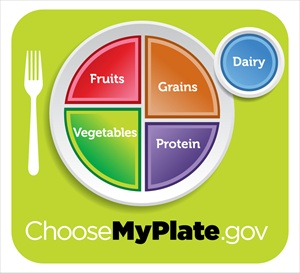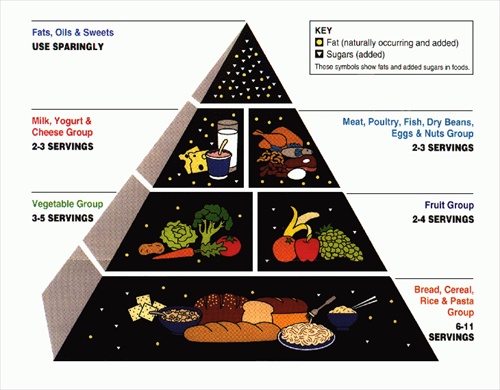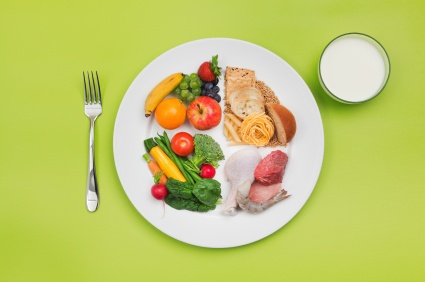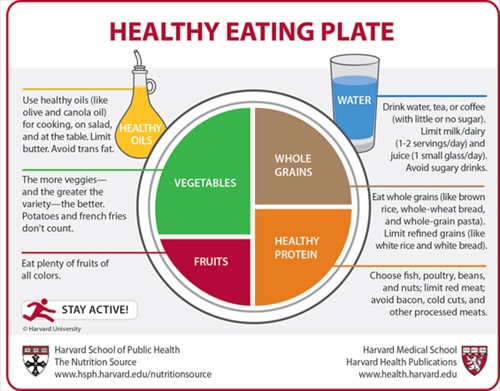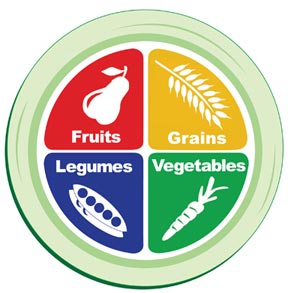How the New Food Pyramid morphed into a plate – Introducing the USDA’s My Plate, Harvard’s Healthy Eating Plate and PCRM's Power Plate
I’d like to introduce to you the US government’s new food pyramid – it’s called my Plate or myPlate. You may not have met.
For years, the USDA’s nutrition guidelines for the five food groups was presented in the shape of a pyramid.
Many international governments and health agencies have had versions of the pyramid. The pyramid shape generally gives a proportional representation as to the volume of food from each of the various food groups a person should aim to eat, whether they be five food groups, six, seven or another number.
Eat the majority of food from the base of the pyramid; eat in moderation foods in the narrow top. In fact, depending on which nutrition food pyramid you reference, the pinnacle of the pyramid often represents optional fats, dessert or junk food.
The nutritional food pyramid was a concept familiar to school children in the US for decades until now.
A New Food Pyramid Takes Shape
In June 2011, the USDA unveiled its new five food groups diagram. The food pyramid, like the Egyptian pyramids at Giza centuries before, was obsolete.
A new food pyramid was born or, more accurately, transformed into the USDA’s Myplate or My Plate diagram.
The idea behind the change to a new food pyramid is that a plate is where most of us eat our food (except for all that munching directly from the package in front of the TV). With the plate shape, it was thought, the public could better imagine relative portion size among the various food groups, than with a pyramid.
… It wasn't bad logic. When was the last time you ate your food on a pyramid?
The Skinny on the New Food Pyramid – The USDA’s Myplate
The basic nutrition guidelines of the USDA's New Food Pyramid - My Plate or Myplate - are straightforward and, in fact, not much different than the USDA’s old food pyramid.
The old food pyramid, like
all USDA nutrition guidelines, was modified regularly every few years,
after much haggling among food industry players and nutrition and health
experts. The protracted discussion and negotiation suggests the food
pyramid, like the new food pyramid myplate, was as much a political as a
public health document.
Factors to Remember with the New Food Pyramid - Myplate
There are three points to remember when considering USDA's My Plate.
We should balance calories:
- enjoy our food but eat less.
- avoid over sized portions.
Foods we should increase:
- Make sure at least half your plate is filled with fruits and vegetables.
- Make at least half our grains whole grains.
- Switch to skim or low fat milk.
Foods to reduce:
- Compare sodium in foods like soup, bread and frozen meals and choose foods with lower numbers.
- Drink water instead of sugary drinks.
Click here for more info about
USDA's Myplate/My Plate
Limitations on the USDA’s New Food Pyramid – My Plate
There are some drawbacks to the USDA’s New Food Pyramid.
While some of its recommendations about the five foods groups are laudable (eat more veg and fruit), some are not as clear or forceful as they could be, in light of a mountain of scientific evidence showing how food (including the good, the bad and the ugly) affect our health.
The unfortunate result is that some important messages about diet and health are obscured or confusing – a troubling situation for a public health document that is so widely disseminated in schools, hospitals and elsewhere.
Being the major government position on diet and nutrition, My Plate/Myplate has influence. It is the basis on which thousands of institutions and people choose the foods they serve or eat. The result? ... The guidelines influence the diet of hundreds of thousands.
Here is a smattering of issues on which the USDA’s new food pyramid – My plate – remains silent or unclear when it comes to the five food groups.
- Why stop at saying only half your daily allotment of grains should be whole grains? Why not suggest that as many of your grains as possible be whole grains – the evidence about fiber for many conditions including maintaining blood sugar and insulin control is well established? Processed and refined grains should form only a minimal part of your diet.
- Why have dairy as an entire food group, suggesting that you need it as part of a nutritious diet when it is not essential and the nutrients found in that food group (calcium) can be found in other non-dairy sources? - Leafy greens, broccoli, beans and tofu contain calcium as well as other important nutrients dairy lacks, including Vitamin C and magnesium, both of which assist calcium absorption in bones.
- Why not direct people to the healthy fats in many vegetable oils as well as certain cold water fish; and advise folks to avoid the unhealthy saturated fats and trans fats made from partially hydrogenated vegetable oil? The evidence about the effect of too much of the unhealthy fats on heart health, diabetes and obesity etc. has grown like a snowball rolling down a hill. The health promoting benefits of fats from cold water fish as well as certain seeds and nuts is established. Why not promote this information?
- Why not mention that most sodium is found in processed or manufactured foods and suggest cutting back on these items?
Once you cut processed foods from your diet, you’ll be dealing with a
lot less sodium and, depending on the processed food, less added sugar
and possibly bad fats. This is where good health and responsible
nutrition intersect and the public needs clear accurate information
about what food choices are good and which are poor. For more on foods that sound healthy but aren't click here.
So … why are some of these important dietary directives absent from the USDA My plate guidelines?
Shouldn't the government's new food pyramid represent the latest in nutrition and health research?
It doesn’t take a rocket scientist (or a nutrition scientist for that matter) to recognize that political factors influence the bottom line message a government agency like the USDA will issue about the health of certain foods or substances; especially when the agency represents both food industry players’ interests and consumers’ health and nutrition interests.
Don’t forget it’s the Department of Agriculture!
No wonder interests may collide when the latest nutrition research suggest that a person reduce or eliminate certain foods like animal protein, dairy, sugar and trans fats from one’s diet. Such advice, while good for health, could affect directly and, for the worse, the economic well being of food industry players.
Changes to the USDA’s new food pyramid along with
changes to government food guidelines in general are like dealing cards
on a hot grill – fingers get burned and the kitchen can get too hot for
comfort.
Harvard School of Public Health’s New Food Pyramid and response to USDA my plate/myplate – Harvard’s alternative Healthy Eating Plate
To deal with some of this criticism of the USDA’s New Food Pyramid’s My Plate, The Harvard School of Public Health published its own New Food Pyramid in Sept 2011 – The school calls it the Healthy Eating Plate
While similar to the USDA myplate, Harvard’s Healthy Eating Plate contains much more detailed nutrition advice than does the USDA’s version of the new food pyramid. For that reason the Harvard plate is easier to understand and gives superior nutrition advice, especially for those who want to include animal products in their diet.
The result is that Harvard’s New Food Pyramid reflects
current nutritional and health research more accurately and more
effectively than the government’s new food pyramid.
Harvard’s Healthy Eating Plate gives additional details on what a person should include as part of a healthy well balanced diet. Just as importantly, it gives … the why along with what to avoid.
A Healthy Diet Involves Choice – Healthy foods belong on the plate – Unhealthy foods stay off or have a minor place
As the US epidemic of obesity and lifestyle diseases stemming in part from poor diet testify, calories are not unlimited.
A healthy diet cannot be about onlyeating as many healthy foods as possible: it’s got to be about choosing the right healthy foods in the right amounts and, as importantly, avoiding the unhealthy ones. We each have to make decisions about the quantity as well as the quality of what we put in our mouths.
Harvard’s Healthy Eating Plate makes this clear; the USDA’s My plate leaves this fuzzy with much wiggle room for unhealthy eating.
Harvard’s New Food Pyramid – the Healthy Eating Plate
Some of the important diet tips from the Harvard Healthy Eating Plate are below:
- The more veggies - and the greater the variety – the better. Potatoes and french fries don’t count. Aim for a myriad of colors and types. Don’t include potatoes and french fries as part of your allotment of vegetables because they’re high in fast digested starches, like processed grains, and play havoc with blood sugar and insulin. “These surges, in the short term, can lead to hunger and overeating, and in the long term, can lead to weight gain, type 2 diabetes, and other health problems.”
- Eat plenty of fruits of all colors. As with vegetables, the colors of fruits generally represent different phytochemicals including vitamins and anti-oxidants etc. so aim for variety when it comes to fruits.
- Eat whole grains (like brown rice, whole-wheat bread and whole-grain pasta). Limit refined grains (like white rice and white bread). The Harvard guidelines pull no punches when stating that whole grains are better for your health than refined grains. The guidelines elaborate how whole grains have a “gentler effect on blood sugar and insulin than white bread” and how “Over time, eating too much of these refined-grain foods can make it harder to control weight and can raise the risk of heart disease and diabetes.” There’s no point avoiding the building blocks for good health.
- Eat healthy sources of protein like fish, poultry, beans and nuts; limit red meat; and avoid bacon, cold cuts and other processed meats. Choose fish, chicken, beans or nuts because fish contain heart –healthy omega 3 fats and beans contain beneficial fiber. The Harvard guidelines state that an egg a day is okay for most people, although diabetics should limit their intake to 3 yolks a week. “Limit red meat—beef, pork, and lamb—and avoid processed meats—bacon, cold cuts, hot dogs, and the like—since over time, regularly eating even small amounts of these foods raises the risk of heart disease, type 2 diabetes, and colon cancer.”
- Use healthy oils, like olive and canola oil for cooking, on salad and at the table. Limit butter. Avoid trans fat.
Use healthy vegetable oils, like olive, canola, soy, corn, sun flower
and peanut oil in cooking, salads and at the table. Limit butter and
avoid trans fats from partially hydrogenated vegetable oils. For more on healthy Omega 3 and Omega 6 oils, press here.
- Drink water, coffee or tea – Limit milk and dairy products to 1 to 2 serving per day. The Harvard New Food Pyramid is clear on this front. Drink water or a cup of tea or coffee with minimal or no sugar. Limit milk and dairy products to one to two servings a day “since high intakes are associated with increased risk of prostate cancer and possibly ovarian cancer.” Limit juice to small glass per day, since is is high in sugar. Avoid sugary drinks since they provide empty calories.Unlike the USDA’s New Food Pyramid guidelines, The Harvard New Food Pyramid doesn’t shy from the fact that “…routinely drinking sugary drinks can lead to weight gain, increase the risk of type 2 diabetes, and possibly increase the risk of heart disease. Is that that soda drink manufacturers aren't lobbying Harvard, like they do government?
- Stay active – Being physically active is the other half of weight control.
For more info on how the Harvard Healthy Eating Plate differs from the USDA’s My Plate, go to
a discussion on Harvard's Healthy Eating Plate and USDA's My Plate - tthe two new food pyramids.
Another Plate to Consider At your Table- The Power Plate
There is another new nutrition pyramid on the block.
The Power Plate, developed by the Physicians Committee for Responsible Medicine in Jan 2011, aims to promote health via a plant based diet - also known as a vegan diet.
The Power Plate dietary theory is backed by extensive research on how a plant based diet, comprised solely of fruits, legumes (beans, lentils and peas), grains and vegetables can prevent and even reverse many of the major lifestyle diseases that plague those who eat the typical animal based Western diet. These include type 2 diabetes, cardiovascular disease, and some types of cancer.
Other benefits of a plant based or vegan diet are lower cholesterol and blood pressure levels as well as easier weight control.
Some Points to Consider When Following The Power Plate Diet
- Eating a wide variety of all plant based foods will give you all the nutrients you require including sufficient protein, iron and calcium, nutrients that non-vegan eaters usually obtain from animal sources such as meat and dairy.
- Despite the above, ensure adequate Vitamin B 12 intake by eating fortified foods or taking supplements. As a general rule, B 12 is not available from plants.
- Serving size and frequency of the "four" food groups is unnecessary,
provided you eat a wide variety of foods from all four groups. There is
no scientific evidence suggesting prioritizing one group over the
other. Consuming excess calories are less of a concern with plant based
whole foods diet, because foods containing animal fat and animal protein
are generally more calorie dense than plant foods containing these
nutrients.
Press here for more information from the Physician's Committee on Responsible Medicine on why you would want to consider a plant based diet like the Power Plate.
For more about healthy diets, click on the below links...
|
Balanced Diet |
Calories |
Food Labels |
My Plate |
Organic |
Vitamins? |
|
Inflammation |
Antioxidants |
Low Glycemic |
Vitamin C |
Cancer |
Omega 3 |
Click for more information about a healthy balanced diet.
Click here to read about the Benefits of Supplements and whether you need them.
Click here to readd about Digestive Enzymes.
Click here to read about Omega 3s and healthy fats.
Click here to read about the Benefits of Vitamin C.
Click here to read about the Benefits of Vitamin D.
Click here to read about Magnesium and Magnesium Foods.
Click here to read about Calcium.
Click here to read about Chromium.
Click here to read about Zinc and Zinc Foods.
Click to read about the benefits of organic food.
Click to read about a cancer prevention diet.
Click to read about a cancer and nutrition.
Click to read about a cancer fighting diet.
Click here to read about Anti-inflammatory Supplements and Anti-inflammatory Diets along with a list of Inflammatory Foods.
Click here to read about Anti-oxidants and Orac Values,
To read more about maintaining even blood sugar, click on Low Glycemic Diets.
For current news on nutrition and food research, check Healthy Diet News Blog.
Click here, to return to Healthy-Diet-Healthy-You.com homepage.
